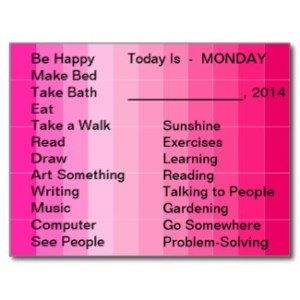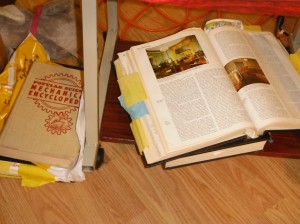Put it where it can be seen.
One of the most important elements for me to work daily in my environment which serves both as my home and workspace, is to put tools where I can see them. Specifically, I mean adaptive living tools which I use every day to help me remember and do things. For a long time, this meant putting a child’s toy of two eggs sunny side up on the counter by the kitchen where I would see them and remember to eat. Along with that, when I was first living independently with my disabilities and even while living with others who were regular people not having my disabilities and couldn’t be trusted to help remember to me when to eat – I had cats. Cats always know when they want to eat, need to eat, haven’t eaten in a while and should be fed. They would definitely tell me when they wanted to eat and then I simply ate at the same time. That and having the little toy eggs sitting somewhere that I would see it, sufficed to remind me about eating and when to do it and to look around for what was available to eat in the fridge.
There are a lot of tools that can be used visually for people with disabilities like head injury, stroke, autism and mental disabilities. None of these tools will help if they can’t be seen. It never ceases to surprise me how many families, caregivers and even mental health professionals still believe a home must look like a picture book or magazine rather than being modified appropriately to the person who must live there and function well daily. To find the placement of things like adaptive living tools around the physical environment where a person works or lives, it takes a couple things for certain to accomplish it logistically, but more practically – if none of those tools can be in the visible environment because they don’t “look right” then it is all for nothing.
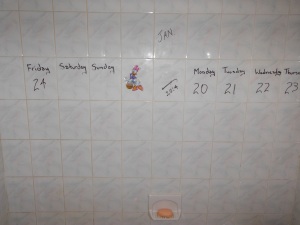
Put it where you can see it – dry erase markers allow me to put the days of the week on the bathtub tile where I notice it. It can be changed easily as each day changes to the next.
On this exploration of using adaptive living tools and compensating strategy tools in the home and work environment, one thing is absolutely necessary and that is the freedom to do it. That includes a kind of freedom to consider anything as available whether it is “suitable” or not – such as toys, color notes, color tacks, dog toys, cat toys, glow in the dark stars and shapes, paper clips with colorful coatings, glittery stickers, kids window decals, dry erase markers, baskets and bins in colors or specific textures, etc. These might not look like a magazine picture’s version of home decor in a fancy magazine when placed appropriately in the environment where the person uses them to remember, to know, to consider, to ask, to go, to do, to remind, to find, to check, or whatever else they are used to do. That has to be okay.

Use Anything That Works Regardless of Its Original Purpose – These tell me visually to work out what works and make sure it works – like the three set positioning of shopping list card, receipts pile and business note on post it on kitchen counter corner next to my usual drink coaster. The glow in the dark star on the corner reminds me where the corner of the counter actually exists in real space as I map my way through the room daily despite other things changing in the environment.
When finding placement spots for each of these tools, there is only one real consideration and that is, what works. And, the first times around placing things, I rarely found that but you might. For me, it took checking where I naturally or automatically looked in a room on the way through and then too, during certain activities such as cooking or taking a bath or getting ready for bed and then after placing them where I usually looked anyway, if it didn’t work there – I moved them until I found what did work. That is the usual process that people have taken when I’ve helped others put these tools into their places too – both caregivers, other family members, roommates, visitors – AND – helpful know betters, have to understand not to move the damn things too. And, that will never happen that way either, so it is good to know that ahead of time. They will always move them at least once – somebody will. So it is good to find places they are less likely to want to move them or need to move them as permanent spots for the tools to be used everyday. The center of the kitchen counter is typically “not” a good spot because it is used for many other activities and commonly used, cleaned, moved around, needed, etc. – even if a person is living by themselves.
The other part is that – certain behavior habits can be made as compensating strategies and tools such as turning on the light over the stove EVERY TIME something is being cooked where it can be known that cooking has been happening there and creating a double check for stove being left on and things like that. The fact is, everyone needs to know of that habit strategy and use it, know what it means and be part of double checking whether things have been turned off or left cooking too long if no one is standing there cooking with it – AND before leaving the apt., office, studio, store or house. The light is turned off once it is checked before leaving only after ascertaining that all appliances – coffee maker, stove, oven, toaster oven, microwave and anything else that has been in use have been checked and turned off. Even with roommates this is important and in offices where there is a community kitchen in use or break room. But, the compensating strategy of turning on the light over the stove when cooking is being done as a signal to everyone that it must be double checked and awareness of that fact – only works if everyone knows what it means – AND – if it is done “this time” and “every time”.

Although Christmas is a few weeks away in yesterday somewhere recently, this stocking is now reminding me of something else by the front door which has more to do with creating art and products online that people will like for next Christmas. I love the artwork on this stocking – and it reminds me to be watching for design as I wander out to places, take photos of flowers and things to use in designs and watch for things on sale from Christmas that might be nice to have.
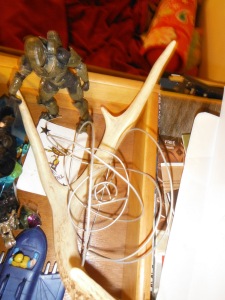
Visual Identifiers that remind me of who I am and what I’m doing that are currently sitting in a drawer on top of a cabinet shelf where I can see them some of the time but notice them as I go by all of the time.
In my environment, color push tacks are used beside door frames to tell me where the doors are to move about my apt. and to tell me where the go out door is. If some one changes those, knocks them out of the wall or walks over to take one to use for putting up a poster or something else, then the tool doesn’t work because it is no longer there. That is to give an example of why it is important that others know why there is a tack next to the door – in an honest way – and that maybe a backup plan is needed on top of the visual identifier I’m using. Redundancy is a good thing in this process but if something works – use it, don’t try to re-work it once it is working – use it that way and go on to something else that isn’t working to do “fixing it.”
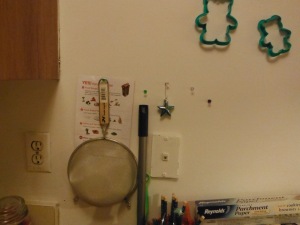
This is on my kitchen wall – the sieve and flyer from recycling food for composting are together which tells me to divide it out and place in its special container. Tacks here are not for a door obviously and are set up differently to remind me of a sequence of activities which must occur when working in the kitchen and where to find things.
First – find where the person who will be using the visual identifiers and adaptive living tools actually looks when coming across a room or during certain activities. For me, that is easily found by asking my self what I just noticed in the room after I’ve walked through it. Now in all honesty, it is a fact that our subconscious minds – even those of people with head injury and other mental disabilities – do actually take in everything despite not noticing it. But for these tools to be effectively used, it is easiest to place them where they are obviously noticed rather than waiting for the subconscious to eventually be asked and answer as to what it means, where it was and why it was needed there at all. As much as I’ve tried photographs from newspapers and magazines of food on the refrigerator, on cabinets, on the kitchen mirror, in other places – and kids coloring book line drawings of hamburgers and magnets and kid’s toys of hamburgers – not one of them worked well for me. Not because I couldn’t identify the hamburger or associate it with eating but because I don’t usually have hamburger and I know it – so my mind would dismiss it. Also as it turns out, I rarely look in the bathroom mirror, even more rarely notice the front of the refrigerator in the room although I do see the protruding upper right corner usually and even more rarely look at my cabinet surfaces. On top of that, it turned out that by trying it – the cabinet surface features for me are part of the room’s walls and environment that I use to map my own way around the physical spaces and so pictures and color stickers and things on top of that surface made physically navigating the room harder. I only know this because of trying it and finding it out which is why that is first and knowing it will have to be done more than once to get what works is very important.
However, that said – if the first time something is placed in that spot which is already noticed in a room – actually works for the compensating strategy or adaptive living tools placement – then use that and don’t change it until it isn’t working and needs to be changed. Because that is the point – finding what works. Find what places are automatically or naturally noticed in the room spaces, place visual identifiers and adaptive living tools in those spaces specifically – if they work, use them there and if they don’t, then move them to somewhere else, modify them or put some other tools there that does work in that space for it. That is the process.

You really can use anything to say things visually. Some things are said by juxtaposition of things with one another. These colorful skeletons work pretty good, but I haven’t had them for very long. Still working to get them right – they can be set all kinds of ways because they are jointed.
Second, visual identifiers can be anything that works – no matter what is the original intended use of the item. These are mnemonic tools in some respect and so they almost must be custom made by the person with the disabilities even if it is with the help of caregivers, family members, rehab problem solving programs or other helpers. Like I said about the hamburger, it turned out that for me, the two eggs sunny side up child’s play food toy worked better than the hamburger because usually there are eggs in the fridge and not hamburgers – but also because they were remarkably more visible in the environments where I live. The one caught my attention and the other did not. That is also, I suppose because of one day that took me three weeks to figure out how to open an egg which I’ll never forget – and it reminds me personally of that. And, no – they don’t have zippers, flaps, or instructions – and they do look solid if you don’t remember that they crack when hit on something. In this case, the play food toy of two eggs sunny side up reminded me to eat something, that there were probably eggs in the fridge and that once I had forgotten how to open them, so I could be conscious of my own limitations as I went to fix me something to eat and do it safely.
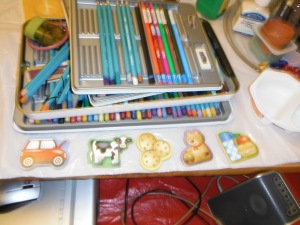
I’m testing these kid’s magnets to see if they could be reminders to eat something, have some milk, have something I like to eat – hence the cookies, although it translates to be whatever I like at the moment on that very day – today that was raisins in the little bitty boxes that I like.
Third, after placing the visual identifiers, mnemonics, compensating strategy tools, and adaptive living tools – add to them, grow with them, alter them as needed, try new things to work for a greater array of abilities and capacities. For me, this meant having a greater range of exercises that enabled me to grow stronger and get better along with including daily activities that I wanted to remember to do in order to live successfully and independently despite my disabilities. It also meant incorporating visual communications into these tools along with their color coded meanings that helped me particularly tell me things that I needed to remember – whether it was shopping needed to be done on Tuesday or to water the plants on Wednesdays every week – or what to buy at the store – or whatever else. For remembering to get the mail, I literally had a forest green mailbox full-sized with the red flag made by Rubbermaid – on my kitchen counter or dining room table or shelf by the front hall near the bathroom where I would see it – otherwise I wouldn’t even know to go out and get the mail at all – and nothing said to me to do it. But, that simple mailbox did that – and it was big enough to see it – big enough to be obvious to everyone else who walked by it who would then ask me if I’d gotten the mail lately or why it was there which would remind me to check the mail too – and it was all of $3 to buy that mailbox at a thrift store to accomplish all those things.
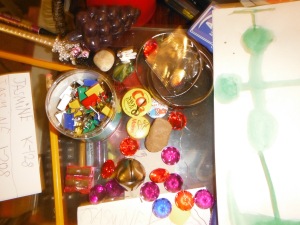
Tools / Visual Identifiers waiting to go into use sitting on a table near where I can easily see them and find them when they are needed.
**
If I could not have had that mailbox sitting inside my house because whomever in my friends and family did not believe a full-sized outdoor mailbox should be sitting on a shelf by the bathroom in the hall or on the kitchen counter, etc – then my opportunities for it to do those things for me would have been non-existent. I could not have checked on the mail myself, because I wouldn’t have remembered it. That seems to me like it would look even sillier and crazier after a point of the mail piling up out there or people having to constantly be my reminder for it – than having a damn green mailbox sitting inside the house as part of the “decor”. But, people have ideas of what should and should not be used for – and some people can be pretty crappy about using things only for what they were originally intended – and in the manner for which they were originally intended – such as putting that mailbox on a post outside for the mail and only that and nothing but that and in only that way and place outside. It is obvious that those people like that have no disabilities they are owning up to – and think that everyone has the luxuries of that which they do. That goes without saying – into a lot of areas including the next one I wanted to add here.
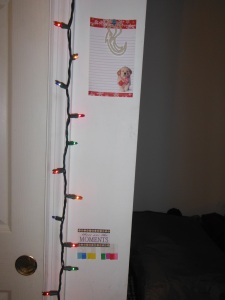
On the wall across from my kitchen, this shopping list, glow in the dark shape and the construct on down the wall – tell me entire volumes of information visually. The shopping list here is not used or written on – had tried it here with a 3×5 card actual list in the first place and it didn’t work, but seeing this old style list notepad like I used to use at one time, reminds me to check the food in the kitchen and to go shopping for it – find the shopping list and use it.
That others don’t have to put their keys in the same place this time and every time in order to function is their life, not my life. For me to not spend the next three or four months of my life lost and in a confused dysfunctional state of chaos – while I’m looking for my keys – it is easier for me to put them in the same place this time and every time as a compensating strategy habit. That is what makes sense for me. If I have a cellphone, the same thing is true – coming into the house and put it in the same place each time and then back to that place – because otherwise everything in my world comes to a halt while I search for the cellphone. People who do not have my disabilities, head injury, post traumatic stress disorder, stroke, and other problems both physical and mental – can throw their phone or keys wherever they land and it might not interrupt more than a few minutes of their lives to go look for them. Good for them – but that is not me and it is not a luxury I have or need. In setting up my living, working, home, studio, store, office, business, workshop, kitchen cooking spaces, and computer areas – I have to remember my strengths, and limitations – my needs and my real aids for compensating skills that overcome my disabilities which I will need in order to use those spaces.

I had friends who would come over, see something like this and dump it “for me” into a box, closet, drawer or in the trash when no one including me had asked them to do that. They thought I should not be “hoarding” things and didn’t understand that these are tools I use to help myself do what they take for granted. Yes, they were grown adults who knew of my disabilities and should’ve known better. And, yes – more than one person did that over the thirty years – especially those who were trying to “help” me.
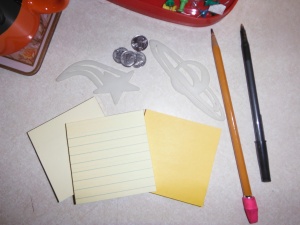
My tools in use on my kitchen counter – off to one side away from where the counter is needed for food making and in a place that I see it whenever I go by it or walk through the room to anywhere else. It is in a very noticeable spot for me which works. In this case, these are used – not left blank but sometimes they are used blank rather than for written notes to be a visual identifier for something.
Because my strengths are visual, I am more inclusive of visual tools, mnemonic tools that are visual, visually based communication skills and adaptive living tools that are inherently more visual oriented. These tools work for many people though whether they have visual strengths left after the injury as mine were or not – however, people with certain disabilities as well as many caregivers do prefer that some of the visual tools have words that identify them along with the colors, shape, form or visual mnemonic that I use.
For instance, where there are caregivers who are verbally oriented, a post-it note folded over in the odd visuals that I use without any words on them rather cheated them of participating in its communication and use when they wanted to be of help to me. I couldn’t have changed it at the time because I wasn’t capable of adding the words that it meant – to the completed visual identifier to show how it was being used and what it was conveying to me and to my children and others. But, if I were making it now, I could add those verbal elements and it would make all the difference to those highly verbal people around me who might want to know what those identifiers, tools and communications in visual languages tell me.
This was to briefly say that making the adaptive living tools work for everyone is not necessary in order to use them – it could be helpful at times though – to add that extra interpretation for those caregivers and other family members and friends to know what it’s purpose conveys. In my life, I’ve noticed that sometimes when a person asked and I told them – like the kid’s play food eggs toy on the kitchen counter – why it was there and to please not “put it away” in the children’s toy box because it wasn’t theirs – sometimes, they’d remember and it would remind them to ask me whether I’d eaten or not, once they knew what it was for.
And, then sometimes some people – they’d just never get it and the next time they saw the thing sitting on the kitchen counter even after being told why it was there, would just have to go put it away – to “help me out” and to “help me get things done which I couldn’t possibly understand how they should be done” in their estimation of it all.
– cricketdiane
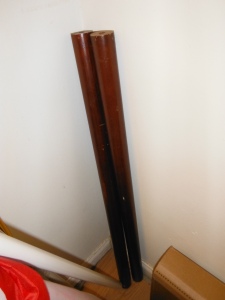
For years I had one long dowel of this size slightly taller than I am which was bought at the hardware store and normally used as a closet dowel rod. By throwing it from one hand to the other, it makes possible to do an entire set of exercises that help me have both hands as well as to shift weight, balance, using both sides of the body and other critical things. Since about seven years ago, I’ve been using two dowel sticks instead – including this set that I use now. It allows me to throw each of them simultaneously across hands which I can do now although it has taken for-ever to learn how to do it and get my hands and body to get it right without dropping them in the process.
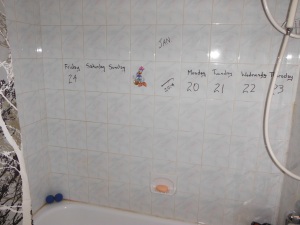
The two blue handballs that I use for my hand exercises and to roll under the center of each foot are sitting in the corner of the bathtub where I can remember to do those exercises. One handball sold with the set of three is kept in my desk area where it is obvious sometimes and it used to be something found in my purse for the same reason.
**
Quick Skill Set –
Never lock the front outside door by the door handle on the way out it – use the key once on the outside only – to keep from getting locked outside without the keys accidentally.
Never assume that you are free to do things your own way in your own house if you have any disabilities at all but especially mental, intellectual, brain physiology, emotional and ptsd ones.
Never believe for one minute that others will know that you need it to be a certain way in your own environment in order for you to function better or that its more important than to have your decor look like a magazine picture or stage set in a sitcom or commercial. People, especially family members have a reputation to be considered and what it looks like is more important than what that environment may enable you to be able to do by looking a little “different”.
Never cook, turn on stove or over, make coffee, make toast or turn on heated things and appliances in the kitchen without turning on the overhead light of the stove – this time and every time. – Never leave the house or go to bed at night before checking to turn off any of those if still on – and then turning off the overhead stove light – this time, every time.
Never put keys, shoes, purse, socks, cellphones, wallet, id, bank cards, benefit cards, coats during winter, somewhere other than their “one place”. They should be easy to find on the way out especially in an emergency – but at any other time as well, without having to look for any of them – and that includes those belonging to children staying with you or spending the night to visit or living with you. It should include all other family members and roommates but they’ll never be doing it that way ever no matter what you say.
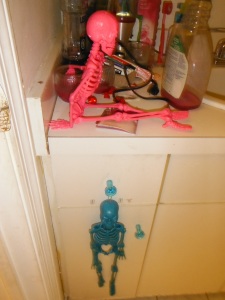
Yes pink skeltie’s hand is in a glass votive candle holder – granddaughter set him up to explain something to me about the stuff sitting on the bathroom counter shelf – and it could break and go everywhere, then I couldn’t walk there. I’m working on fixing that now.
NEVER, NEVER, NEVER assume that anyone – no matter how much they know about your disabilities will think you need to do things a bit differently in order to get the same success and opportunities to do them – whether it is getting shoes tied or starting a business or making sure to take a bath every day or so – or any of the other infinite array of skills, activities and daily living requirements, outings, work opportunities, etc. Even professionals in the field, family members who should know better, caregivers that do know better and friends that might want to understand – are not going to get it concerning why doing it exactly the same way they do – does not get the same results or get those results without severe repercussions as you would have from it. Even when they see it – they don’t see it because from where they stand, that problem simply doesn’t exist for them.
– cricketdiane
**

Okay, not a magazine picture decor, but it works for me and because it is able to be this way freely – I can function and live independently along with continuing to get better every day. It works.
**
